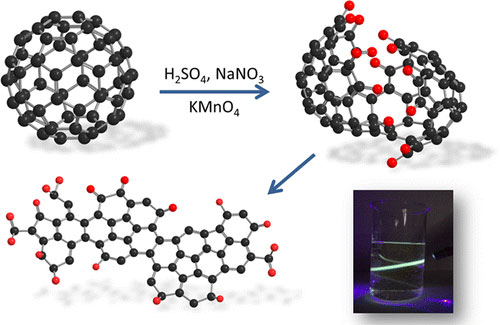Graphene Quantum Dots: Breakthroughs in Bioimaging, Photovoltaics, Catalysis, and Drug Delivery
What are Graphene Quantum Dots?
Graphene quantum dots (GQDs) are nanoscale fragments of graphene with lateral dimensions typically below 100 nanometers. These tiny nanostructures exhibit unique electronic, optical, and chemical properties that arise from their quantum confinement and edge effects. GQDs are considered zero-dimensional (0D) nanomaterials due to their confinement in all spatial dimensions.

Synthesis of Graphene Quantum Dots
There are several methods for synthesizing GQDs, which can be broadly classified into top-down and bottom-up approaches:
Top-Down Methods
- Oxidative Cutting: Graphene or graphene oxide sheets are chemically cut into smaller fragments using strong oxidizing agents like nitric acid or potassium permanganate.
- Electrochemical Exfoliation: Graphene sheets are electrochemically exfoliated and simultaneously cut into GQDs using an applied voltage in an electrolyte solution.
- Hydrothermal/Solvothermal Cutting: Graphene or graphene oxide is treated under high temperature and pressure conditions in a solvent, leading to the formation of GQDs.
Bottom-Up Methods
- Carbonization of Organic Precursors: Organic molecules like citric acid or glucose are carbonized at high temperatures to form GQDs.
- Chemical Vapor Deposition (CVD): GQDs are directly grown on substrates using gas-phase precursors under controlled conditions.
Properties and Characteristics of Graphene Quantum Dots
GQDs exhibit several unique properties that make them attractive for various applications:
Electronic Properties
GQDs have a nonzero bandgap due to quantum confinement effects, unlike bulk graphene, which is a zero-bandgap semiconductor. The bandgap of GQDs can be tuned by controlling their size, shape, and edge structure. This bandgap tunability makes GQDs promising for electronic and optoelectronic applications.
Optical Properties
GQDs exhibit strong light absorption and photoluminescence properties. They can absorb light over a wide range of wavelengths and emit bright, tunable fluorescence depending on their size and surface chemistry. The photoluminescence quantum yield of GQDs can be as high as 50-60%, making them attractive for bioimaging, sensing, and light-emitting applications.
Chemical Properties
GQDs have a high surface-to-volume ratio and abundant edge sites, which can be functionalized with various chemical groups. This surface functionality allows GQDs to interact with other molecules or materials, enabling their use in sensing, catalysis, and drug delivery applications. GQDs also exhibit excellent biocompatibility and low toxicity, making them suitable for biomedical applications.
Real-World Applications and Breakthroughs
The unique properties of GQDs have led to their exploration in a wide range of applications. Here are some specific examples and recent breakthroughs:
Bioimaging and Biosensing
GQDs have shown great promise as fluorescent probes for bioimaging and biosensing. One such study details a GQD-based fluorometric sensor capable of detecting acetylcholinesterase (AChE) with a detection limit of 0.58 pM, using a photoluminescence 'turn-off' strategy. This 'mix-and-detect' sensor can identify compounds that inhibit AChE, including nerve gases, pesticides, and drugs like paraoxon, tacrine for Alzheimer's, and dopamine, showcasing broad application potential for early diagnosis and prevention
Photovoltaics and Optoelectronics
Studies have demonstrated that graphene quantum dots (GQDs) can be used to improve the efficiency of solar cells and LEDs. In one notable study, nitrogen-doped graphene quantum dots (N-GQDs) were developed to enhance the power conversion efficiency of inorganic perovskite solar cells beyond 16%. These N-GQDs were able to convert harmful UV light into useful visible photons, which contributes to increased solar cell efficiency. This strategy also highlighted the stability of N-GQDs under conditions of high temperature and humidity, indicating their potential for practical applications
Catalysis
GQDs have shown excellent catalytic activity in various chemical reactions. For instance, researchers have synthesized sulfur-doped graphene oxide quantum dots and investigated for efficient photocatalytic hydrogen generation application. These metal-free and inexpensive GQDs hold great potential in the development of sustainable and environmentally friendly photocatalysts for efficient hydrogen generation from water splitting.
Drug Delivery
GQDs have been explored as nanocarriers for targeted drug delivery. A recent study reports a multifunctional biocompatible anticancer nanoformulation to provide targeted image-guided cancer-selective therapeutics. Specifically, nitrogen-doped graphene quantum dots are covalently bound to ferrocene cancer-selective therapeutic and hyaluronic acid targeting agent. It provides GQD fluorescence image-tracked preferential accumulation in cancer cells with cytotoxic responses in cancer cells and minimal/no toxicity in regular cells.
Challenges and Future Perspectives
Despite the remarkable progress in GQD research, several challenges remain. Precise control over the size, shape, and edge structure of GQDs during synthesis is crucial for tailoring their properties for specific applications. Understanding the structure-property relationships of GQDs will enable the rational design of GQDs with desired characteristics.
Future research directions in GQDs include the development of large-scale, environmentally friendly synthesis methods and the exploration of new functionalization strategies. The integration of GQDs with other nanomaterials, such as metal nanoparticles or 2D materials, can create multifunctional nanocomposites with enhanced properties. Additionally, theoretical modeling and simulations will play a crucial role in understanding the fundamental properties and mechanisms of GQDs, guiding experimental efforts.
Further Reading
Journal of Energy Storage, Graphene quantum dots and its modified application for energy storage and conversion
